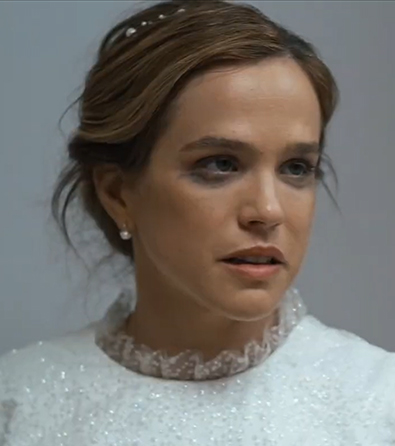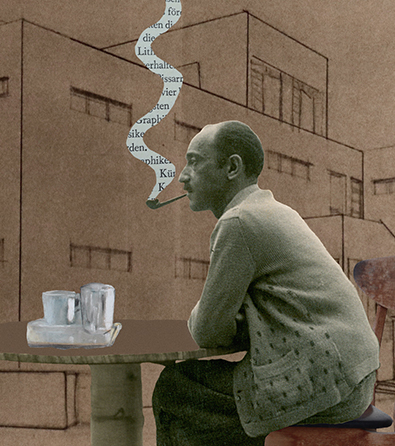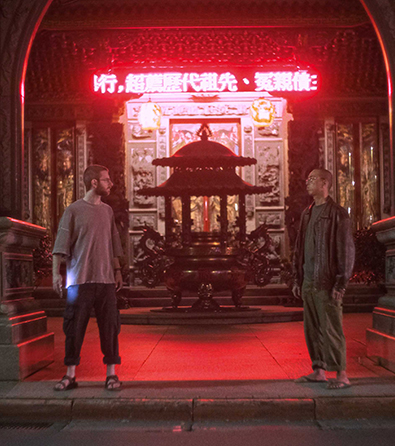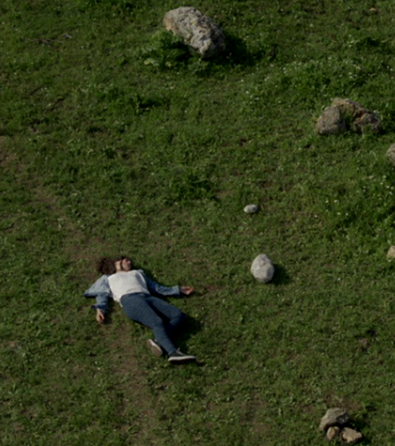The short film Livorno (11 minutes) is available at the top of the page.
* To watch this film, please approve YouTube/Vimeo cookies via the blue cookie icon at the bottom left of the screen
Miki Polonski is among the Israeli filmmakers who have most clearly succeeded in developing a distinctive cinematic signature within the short film format. His artistic voice – woven consistently through the six award-winning shorts he directed between 2013 and 2020 – has earned him retrospectives at international festivals. Livorno (2016) exemplifies this signature: a thematic and aesthetic exploration of shared housing structures, working-class neighborhoods, and apartment blocks; restrained, often wide and extended shots that reveal the human experience as much as they obscure it; and a use of silence that generates a deep and unsettling tension.
Livorno is set like a piece of black paper folded in half. The five nocturnal shots that comprise the film create a symmetrical structure, almost a palindrome. The first and last shots capture, from the same angle, a building set between several others. The second and fourth shots also share an identical composition: two rooms in an apartment, separated by a wall that divides the frame in two. In one room, a mother, a dog, and a television broadcasting in Russian; in the other, a son. Between them lies the third and longest shot, the heart of the film, in which a crime unfolds: the theft of bicycles.
The theft takes place after the boy’s father calls the apartment’s phone. The boy insists he cannot go downstairs, reminds his father that he promised they would stop doing this, says he doesn’t want to do it again, and accuses him of always lying. In the end, he yields to his father. In a shot that slowly tilts down through the apartment window, we see the boy meet a man waiting below the building, next to a car with two bicycles strapped to its roof. The distance and darkness make it difficult to make out all the details from the elevated point of view, but we can see the boy embrace the man, climb over a locked school gate, wait for the man to hand him an object, run across the schoolyard until he disappears behind a structure, and return – first with one bicycle, then with a second. The boy then walks back toward the building, while the man remains with the stash of stolen bicycles. The shot, still filmed from inside the apartment, continues as the man lights a cigarette, gets into the car, and drives off. Suddenly, the boy appears in the foreground of the frame, between the camera and the window. His sweaty, panting back is turned to the viewer, his face directed toward the street. A moment later, he turns to his mother’s bedroom, sits beside her, and watches television.
The film’s focus on a father, a son, and the theft of a bicycle vividly echoes the narrative elements of one of the seminal works of Italian neorealism: “Bicycle Thieves” (1948) by Vittorio De Sica. The choice to name the film Livorno – after both a port city in Tuscany and a street in Bat Yam, the Israeli town where Polonski grew up – can be read as a subtle wink from the director, suggesting the deliberate hand behind this intertextual reference. Comparing the two films offers a useful key to interpreting Livorno, whose conciseness leaves ample space for the viewer’s interpretation.
In De Sica’s film, the father, Antonio, is a working-class man in post-World War II Rome, whose bicycle on which his livelihood depends is stolen from him. After a prolonged search for the bicycle with his young son Bruno, the desperate Antonio attempts to steal a bicycle himself. The attempt fails as he is caught in front of his son, and then released out of pity. Father and son walk home in tears, hand in hand. It is a crime driven by financial distress, and its resolution with the close-up of the father’s tear-streaked face, exposed in a moment of weakness and shame before his child, imbues “Bicycle Thieves” with a tone of moral redemption.
By contrast, in Livorno, the father-initiated act of theft does not stem from a single moment of despair after all other possibilities have been exhausted. The boy’s pleas make it clear that this is a recurring crime. The fact that multiple bicycles are stolen that evening further reminds us that this is not about retrieving a single vehicle essential for the father’s livelihood. The crime carries an element of excess; it is a planned and systematic act. The one acting under pressure, is the son. Compared to Bruno, the boy in Livorno is not a moral compass or passive observer – he is an accomplice, who is well beyond his first transgression. In Livorno, we do not witness the collapse of a moral backbone, but yet another failed attempt to rebuild one.
The sense of repetition and entrapment within an inescapable cycle is intensified by the film’s recurring compositions, which lend Livorno a pendulum-like rhythm. In this way, the film challenges the classical cinematic narrative structure that seeks progression, climax, and resolution. One might say that the social determinism it conveys is reminiscent of the real-life story of the lead actor in “Bicycle Thieves”. Lamberto Maggiorani, who portrayed the father, Antonio, was a factory worker discovered by De Sica during the casting process. “Bicycle Thieves” brought him temporary fame and the payment he received enabled his family to take a vacation and purchase furniture. Later, however, Maggiorani – wrongly regarded as a success story worth millions – was fired from the factory, struggled to establish an acting career, and was occasionally cast as an extra while continuingly seeking odd jobs. A Life Magazine article noted that he would have preferred his previous job to the life of a film star. In the end, the idealistic social cinema that had lifted him out of his former life cast him back down into the very reality its creators had sought to change.
Alongside the immense human beauty of “Bicycle Thieves”, the painful irony of Maggiorani’s life story casts doubt on the moral catharsis the film appears to offer its viewers. In Livorno, instead of enjoying a redemptive resolution, the viewers find themselves peering through a window at a crime carried out without any visible sign of remorse, unfolding right under their noses. This voyeuristic position raises the question of whether the viewer, too, is a silent accomplice to the injustices of society, somewhat like spectators of “Bicycle Thieves” who might weep over Maggiorani’s performance, while oblivious of how it ultimately left him destitute and without anyone to show him mercy.
Another key distinction between the two films lies in their aesthetic approach. Film theorist and critic André Bazin described “Bicycle Thieves” as a film with a transparent, naturalistic directorial style, remarkable in its ability to suppress cinematic artifice to make full space for observing a fragment of lived reality. Livorno, by contrast, is defined by a pronounced aesthetic presence, to the point where the camera itself feels like an additional participant in the film, as if it were documenting its own operation as much as the scene it records. The use of prolonged takes, the slow downward camera movement, and the boy’s sudden appearance in the foreground suggest that Polonski is reconstructing the foundations of neorealist storytelling through a visual language shaped not by typical neo-realist aesthetic, but by the influence of Andrei Tarkovsky.
In Livorno, as in Tarkovsky’s work, the extended duration of distinctly stylized shots draws the screen time closer to real time, while bringing the viewer’s attention closer to both. When we observe a single take in which the boy appears outside the building, far below the overhead camera, and later reappears inside the apartment, his back nearly brushing the lens, we experience a palpable certainty that while the camera continued to roll, the actor completed the entire ascent. This knowledge produces a deterministic effect of motion: a body moving along fixed paths, up and down, on a track from which there is no deviation. Alongside this certainty, the character’s disappearance from and reentry into the frame also serves as a reminder of cinema’s limitations: it can only reveal those fragments of reality it succeeds in capturing. If reality continues beyond the viewer’s line of sight, then the viewer must accept that it lies beyond their control. The optical distance maintained from the characters, with the son’s back turned to the camera and the parents’ faces never revealed, leaves the viewer in partial darkness, withholding any fixed emotional reading of the events. When the sweaty, breathless boy, just returned from his encounter with his father, enters his sleeping mother’s bedroom and sits to watch television in the dark, the camera remains still, holding the wide frame that encompasses both rooms. In the absence of a close-up on tear-filled eyes or a hand reaching for a parent’s, the viewer is left to wonder what the boy feels behind his impassive expression, in the face of the submission he has just experienced and the crime he did not wish to commit.
Within this uncertainty, the film allows space for the viewer to encounter the emotional undercurrents that emerge from the darkness of its frames – to linger on the pinpoint of light that is an airplane crossing the sky in the final shot, or to reflect on the opening image of a woman in the illuminated square of one window and a man in another, sharing the same building yet living parallel lives in separate apartments. Existence in the film is fractured: between rooms; between characters who never engage in a conversation where more than one human voice is heard; between languages – Hebrew and Russian – thus hinting at the experience of identity fragmentation in the wake of immigration; between interior and exterior; and above all, between above and below, a divide emphasized by the camera’s downward movement in the third shot and its low-angle perspective in the first and last. The alienation these images convey invites associations with the Tower of Babel, with rigid social hierarchies, and – through a more fatalistic lens – with the divide between heaven and earth, or even a descent through the levels of the inferno.
Livorno is a film that carries an intimate resonance, one that might echo the trace of a childhood memory. At the same time, it functions just as powerfully as an allegory: the child of aliyah, living in a place that mimics distant Europe through its name, repeatedly serving the needs-or perhaps the whims-of the father’s generation, as he becomes an apprentice thief who steals in the dead of night from an institution meant to educate the next generation. If redemption does not emerge from within the film to transform reality and break the cycle of theft, then perhaps it is the viewer who must ask what they can do to bring it about.















